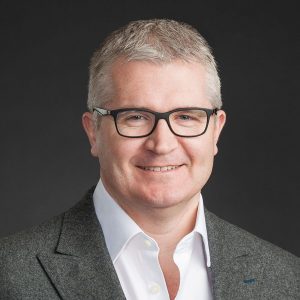A high tibial osteotomy followed by a partial knee replacement enable Physio and Army Reserve Mark to return to his active lifestyle.
Mark, 52, is a physiotherapist with a large practice in south-west London, Physio4life, who’s always pushed himself hard with sport and physical activity. Mark’s knee injury was brought about by excessive use of military training with the British Army, where he is a physio with the reserves. After three years of trying physio, arthroscopic intervention and cortisone injections, Mark sought out Professor Wilson with a view to having knee surgery. Mark had struggled with severe knee osteoarthritis for years and day-to-day activity and walking were becoming problematic.
I had minimal pain following surgery which was brilliant and was able to walk with a normal gait pain-free by day three post-surgery. Professor Wilson and his team have been amazing throughout the last two years and I highly recommend anyone with knee problems who requires surgical intervention to pay him a visit.
TAGGED INProf Adrian Wilson
Knee arthritis / osteoarthritis
Knee osteotomy (realignment) surgery
The London Knee Osteotomy Centre
When physiotherapy and injections failed, Mark needed a permanent solution to his knee discomfort to return to playing sport and his army duties.
Professor Wilson observed that Mark displayed noticeable thrust and ‘wobble’ as he walked and was displaying bent or ‘varus’ leg. This varus leg meant Mark was unsuitable for a partial knee replacement and he also had some instability from his medial collateral ligament (inner side of the knee) having had a significant medial collateral ligament (MCL) injury in the past. Professor Wilson therefore opted to straighten the leg and re-tension the MCL by carrying out a high tibial osteotomy. This technique involves taking pressure off the damaged side of the knee by dividing the bone and realigning the limb and is effective in dealing with the MCL as well as medial (inner knee) arthritis.
This treatment was a success and got Mark walking normally and left him with a straight and stable leg. He did, however, still have discomfort with sport and physical activity.
Two years after the osteotomy, because Mark’s leg was now straight, Professor Wilson was now able to perform a successful medial partial knee replacement.
Three days after his surgery, Mark is pain-free and walking without his crutches. Although early days, he expects to be able to resume his duties with the army and activities like hiking and skiing which are crucial to his mental wellbeing.
Mark says: “I had minimal pain following surgery which was brilliant and was able to walk with a normal gait pain-free by day three post-surgery. Professor Wilson and his team have been amazing throughout the last two years and I highly recommend anyone with knee problems who requires surgical intervention to pay him a visit.”
This is a good example of how osteotomy can be used to enable other joint preservation techniques and stabilise ligaments.

Looking to speak to our team? Call us on 020 7046 8000 020 7046 8085
To book an appointment
or refer a patient
